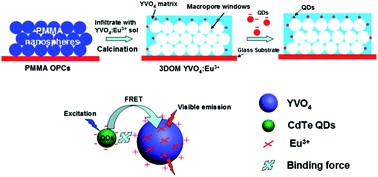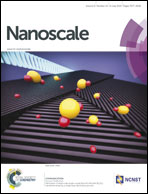Efficient energy transfer from inserted CdTe quantum dots to YVO4:Eu3+ inverse opals: a novel strategy to improve and expand visible excitation of rare earth ions
Abstract
Rare earth (RE)-based phosphors demonstrate sharp emission lines, long lifetimes and high luminescence quantum yields; thus, they have been employed in various photoelectric devices, such as light-emitting diodes (LEDs) and solar spectral converters. However, their applications are largely confined by their narrow excitation bands and small absorption cross sections of 4f–4f transitions. In this paper, we demonstrate a novel strategy to improve and expand the visible excitation bands of Eu3+ ions through the interface energy transfer (ET) from CdTe quantum dots (QDs) to YVO4:Eu3+ inverse opal photonic crystals (IOPCs). The significant effects observed in the CdTe QDs/YVO4:Eu3+ IOPCs composites were that the excitation of Eu3+ ions was continuously extended from 450 to 590 nm and that the emission intensity of the 5D0–7FJ transitions was enhanced ∼20-fold, corresponding to the intrinsic 7F1–5D1 excitation at 538 nm. Furthermore, in the IOPC network, the ET efficiency from the QDs to YVO4:Eu3+ was greatly improved because of the suppression of energy migration among the CdTe QDs, which gave an optimum ET efficiency as high as 47%. Besides, the modulation of photonic stop bands (PSBs) on the radiative transition rates of the QDs and Eu3+ ions was studied, which showed that the decay lifetime constants for Eu3+ ions were independent of PSBs, while those of QDs demonstrated a suppression in the PSBs. Their physical nature was explained theoretically.


 Please wait while we load your content...
Please wait while we load your content...